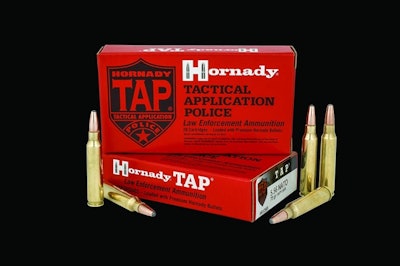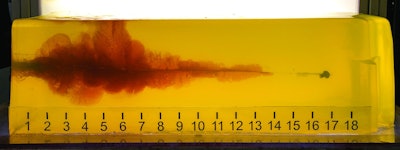
About two years ago a law enforcement sales representative for ammunition maker Hornady Manufacturing learned that more and more agencies were testing and even fielding short-barreled rifle (SBR) versions of AR-15s. The representative said some of his police customers preferred SBRs because their size made them easier to use in urban operations than full-size ARs. However, the customers said they were not satisfied with the ammunition choices available for these guns. So Hornady decided to make a new version of its trademarked Tactical Application Police (TAP) ammunition to solve the problem.
Jayden Quinlan, a ballistics engineer for Hornady, says the issues experienced by many law enforcement SBR shooters stem from firing standard 5.56mm NATO rounds that were designed as ammunition for rifles with 20-inch, 16-inch, or 14.5-inch barrels in the 10.5-inch and 11.5-inch barrels of the SBRs. "When you go from a longer barrel to a shorter barrel, you are limiting the amount of time the propellant has to burn and subsequently accelerate the projectile," he says.
Shooting standard AR ammo out of an SBR can have a variety of undesirable effects, including:
- The incomplete burn of the powder causes reduced muzzle velocity, terminal performance, and accuracy.
- Expulsion of unburned powder from the barrel, which results in a large muzzle flash and possible accuracy degradation due to unburned powder grains striking the bullet at muzzle exit.
- A dirtier weapon because the burn of the powder is so inefficient.
- Louder sound signature even with suppressors.
- Increased felt recoil and back pressure.
Hornady's new 75-grain TAP SBR round was the result of more than a year-and-a-half of painstaking research, development, and experimentation.
And since most of the problems with firing a standard AR round from an SBR are caused by inefficient powder burn, the propellant formulation was a key focus of the project. "We designed a powder solution from the ground up specifically for this application," says Quinlan, who adds that the formula was tweaked numerous times to make it even more efficient.
 Photo: Hornady
Photo: Hornady
A bullet was also designed from the ground up to match the performance of the powder and meet the needs of Hornady's law enforcement customers that use SBRs. "We were not getting the terminal performance we wanted from existing bullet designs at velocities between those of a pistol and a rifle," Quinlan says.
Hornady says the new 75-grain TAP SBR round offers SBR shooters much better performance than standard 5.56mm NATO rounds. The company's test shooters consistently fire 2-inch groups of five rounds at 100 yards using the 75-grain TAP SBR ammo from a variety of SBRs, according to Quinlan.
And improved accuracy is not the only benefit the new Hornady ammo offers SBR shooters, especially for shooters who use suppressors. "Our new TAP SBR round is cooler burning and burns more completely so the temperature input into the suppressor is less." The result, according to Quinlan, is a 6- to 7-decibel reduction in noise over a standard AR round in a suppressed SBR.
Hornady's new 75-grain TAP SBR round is now available, and Quinlan says the ammunition is getting favorable reviews from users. "I got a call from one of our police customers recently. He said he had just witnessed our ammo perform in the FBI protocol, and he had shot it. He said he could feel the difference in recoil and back pressure. He said he planned to switch ammo as soon as the paperwork could be completed."
















